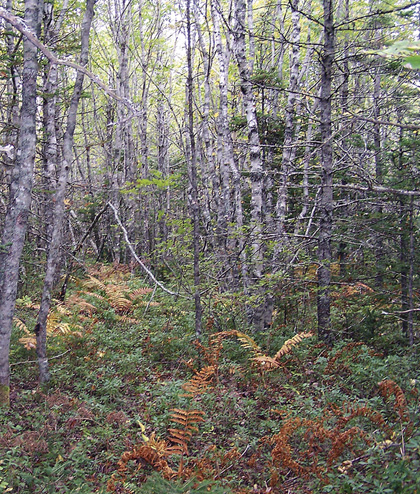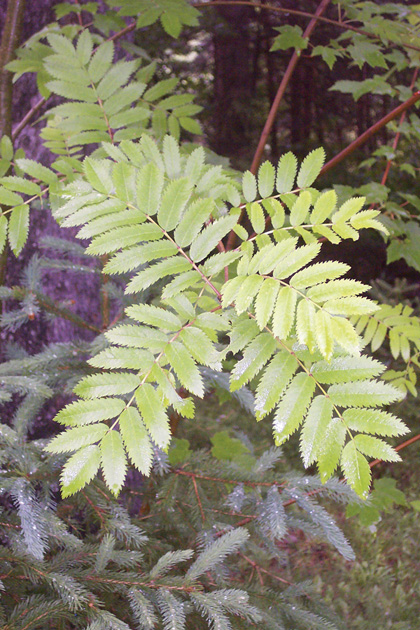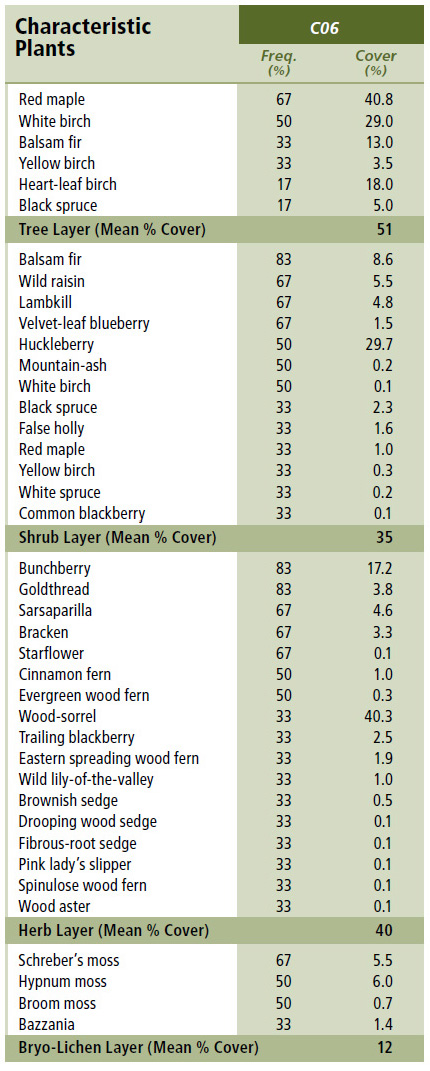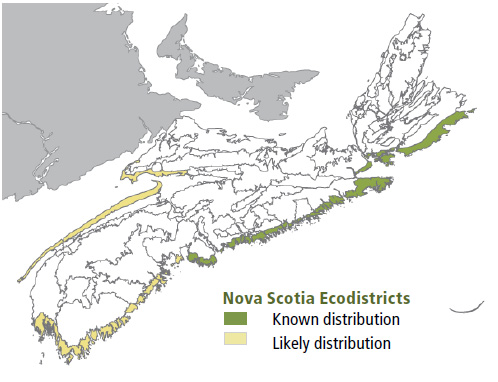
Forest Vegetation types - CO6
CO6 — Red maple - Birch / Bunchberry - Sarsaparilla
Acer rubrum - Betula spp. / Cornus canadensis - Aralia nudicaulis
 |
Blanche, Shelburne County |
Concept: This late successional Vegetation Type (VT) has an overstory dominated by red maple and/or white birch. Extensive conifer regeneration often dominates the shrub layer. Red maple - White birch / Bunchberry - arsaparilla is usually associated with more sheltered sites within the Atlantic Coastal ecoregion.
Vegetation: Red maple and white birch are the dominant overstory trees with balsam fir as a common associate. Heart-leaf birch (a species confined to the Coastal and Highland ecoregions) and yellow birch are sometimes found scattered in the overstory, while red oak, white pine and white spruce may also be present in western Nova Scotia. The shrub layer is often dominated by regenerating balsam fir. Other shrubs may include wild raisin, huckleberry, lambkill and mountain-ash (which can sometimes attain overstory height). Herb layer diversity is low, and bunchberry, goldthread, sarsaparilla, wood sorrel and bracken are common. The bryophyte layer is relatively well developed for a hardwood VT, dominated by Schreber's and hypnum mosses. Bazzania can also be found where coarse woody debris has accumulated on the forest floor.
Environmental Setting: CO6 is associated with fresh to moist, nutrient medium to rich soils of glacial origin. These soils are generally medium to coarse textured. This VT occurs on relatively well drained upper and middle slopes of gentle terrain along the Atlantic coastline. Sites are generally more sheltered than those associated with softwood dominated VTs in this group (CO1 - CO4). CO6 likely occurs in coastal areas of both New Brunswick and Prince Edward Island, but has not been documented.
Successional Dynamics: : CO6 is a late successional VT dominated by red maple and white birch. This even-aged VT typically follows stand-replacing disturbances such as windthrow, breakage, insect infestation and harvesting. Although still influenced by wind and exposure, like other coastal VTs, increased shelter allows hardwood tree species to rise above softwoods on CO6 sites. However, softwoods (particularly balsam fir) will often dominate disturbed areas until hardwoods become re-established. CO5 (White birch - Balsam fir / Foxberry - Wood aster) is a mid-successional stage.
Ecological Features: This small patch white birch and red maple forest is principally associated with the Maritime Boreal Atlantic Coastal ecoregion. It is usually found further inland, protected by seaward stands of spruce and fir forest or on sites sheltered from coastal winds and salt spray. Young red maple shoots are a food source favoured by deer. The canopy of red maples and white birch provide excellent nesting cover for many species of birds. Seeds of both species are eaten by a variety of small mammals that find cover in tree cavities and woody debris. Wild raisin, huckleberry, blueberry and mountain-ash provide important seasonal berry crops.
 |
| Mountain-ash |
Distinguishing Features: Red maple and white birch are common in the overstory of this coastal mixedwood forest. Though not always present, mountain-ash, heart-leaf birch, foxberry and bazzania are indicators of a coastal influence. Moss coverage on the forest floor is still extensive even with the hardwood overstory.
| Slope Position: | Middle5 Upper3 Level2 |
Surface Stoniness: |
(Very - Excessively)5 (Moderately)3 (Non - Slightly)2 |
Bedrock Outcrop: |
(Non-rocky)8 (Slightly - Moderately)2 |
Elevation Range: |
33 - 121m |
Slope Gradient: |
Moderate5 Gentle3 Level2 |
Aspect: |
North2 East2 South2 West2 None2 |
Exposure: |
Exposed8 Mod. exposed2 |
Microtopography: |
Slightly5 Moderately3 Strongly2 |
Drainage: |
Moderately well5 Imperfect3 Well2 |
Soil Type: |
ST2-L3 ST33 nd3 |
Parent Material: |
Glacial till8 Colluvium2 |
Rooting Depth (cm): |
(<30)2 (30-45)5 (>45)1 nd2 |
Duff Thickness (cm): |
(6-10)3 (11-20)3 nd3 |

